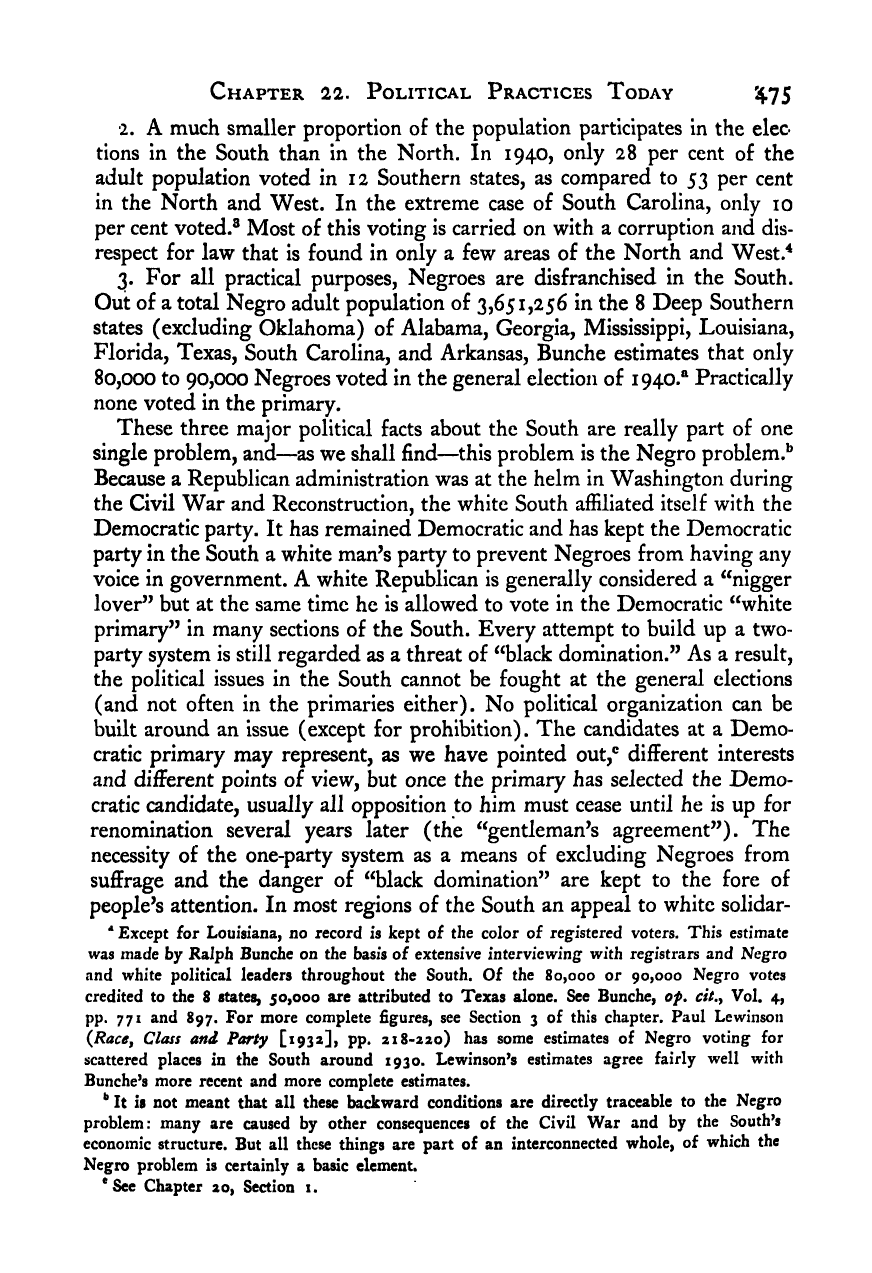Note: Gunnar Myrdal died in 1987, less than 70 years ago. Therefore, this work is protected by copyright, restricting your legal rights to reproduce it. However, you are welcome to view it on screen, as you do now. Read more about copyright.
Full resolution (TIFF) - On this page / på denna sida - V. Politics - 22. Political Practices Today - 1. The Southern Political Scene

<< prev. page << föreg. sida << >> nästa sida >> next page >>
Below is the raw OCR text
from the above scanned image.
Do you see an error? Proofread the page now!
Här nedan syns maskintolkade texten från faksimilbilden ovan.
Ser du något fel? Korrekturläs sidan nu!
This page has never been proofread. / Denna sida har aldrig korrekturlästs.
Chapter 22. Political Practices Today ’475
•2. A much smaller proportion of the population participates in the elec-
tions in the South than in the North. In 1940, only 28 per cent of the
adult population voted in 12 Southern states, as compared to 53 per cent
in the North and West. In the extreme case of South Carolina, only 10
per cent voted.® Most of this voting is carried on with a corruption and dis-
respect for law that is found in only a few areas of the North and West.**
3. For all practical purposes, Negroes are disfranchised in the South.
Out of a total Negro adult population of 3,651,256 in the 8 Deep Southern
states (excluding Oklahoma) of Alabama, Georgia, Mississippi, Louisiana,
Florida, Texas, South Carolina, and Arkansas, Bunche estimates that only
80,000 to 90,000 Negroes voted in the general election of 1940.*^ Practically
none voted in the primary.
These three major political facts about the South are really part of one
single problem, and—as we shall find—this problem is the Negro problem.*^
Because a Republican administration was at the helm in Washington during
the Civil War and Reconstruction, the white South affiliated itself with the
Democratic party. It has remained Democratic and has kept the Democratic
party in the South a white man^s party to prevent Negroes from having any
voice in government. A white Republican is generally considered a ^^nigger
lover” but at the same time he is allowed to vote in the Democratic ‘‘white
primary” in many sections of the South. Every attempt to build up a two-
party system is still regarded as a threat of “black domination.” As a result,
the political issues in the South cannot be fought at the general elections
(and not often in the primaries either). No political organization can be
built around an issue (except for prohibition). The candidates at a Demo-
cratic primary may represent, as we have pointed out,® different interests
and different points of view, but once the primary has selected the Demo-
cratic candidate, usually all opposition to him must cease until he is up for
renomination several years later (the “gentleman’s agreement”). The
necessity of the one-party system as a means of excluding Negroes from
suffrage and the danger of “black domination” are kept to the fore of
people’s attention. In most regions of the South an appeal to white solidar-
* Except for Louisiana, no record is kept of the color of registered voters. This estimate
was made by Ralph Bunche on the basis of extensive interviewing with registrars and Negro
and white political leaders throughout the South, Of the 80,000 or 90,000 Negro votes
credited to the 8 states, 50,000 are attributed to Texas alone. See Bunche, op, cit,y Vol. 4,
pp. 771 and 897. For more complete figures, see Section 3 of this chapter. Paul Lewinson
{Racey Class and Party [1932], pp. 218-220) has some estimates of Negro voting for
scattered places in the South around 1930. Lewinson’s estimates agree fairly well with
Bunche’s more recent and more complete estimates.
**
It is not meant that all these backward conditions are directly traceable to the Negro
problem: many are caused by other consequences of the Civil War and by the South^s
economic structure. But all these things are part of an interconnected whole, of which the
Negro problem is certainly a basic element.
‘See Chapter ao, Section x.
<< prev. page << föreg. sida << >> nästa sida >> next page >>